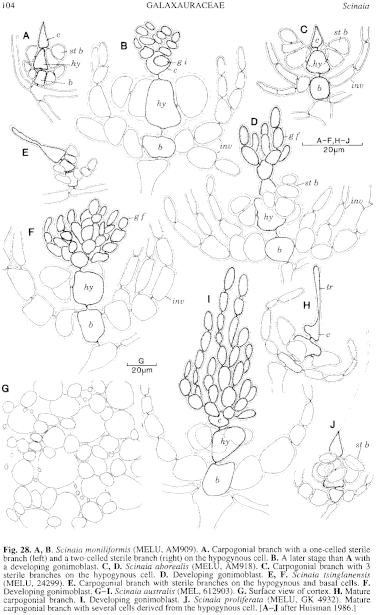|
|
|
|
|
|||||||||||
|
Electronic Flora of South Australia Species Fact Sheet
Phylum Rhodophyta – Class Florideophyceae – Order Nemaliales – Family Galaxauraceae
Selected citations: Setchell 1914: 105, figs 31,32. Huisman 1986: 272, figs 1–12. Levring 1953: 511, fig. 41. Millar 1990: 309, fig. 7D–F.
Thallus (Fig. 27A) medium brown-red, (5–) 10–22 cm high, subdichotomously branched usually from each segment, regularly constricted into ovoid segments 6–15 (–17) mm long and 3–5 mm in diameter. Holdfast discoid, 1–2 mm across; epilithic. Structure multiaxial, developing a central axial core of slender entwined filaments 2–3 (–10) µm in diameter, of very long cells, from which radiate numerous dichotomous medullary filaments, with a cortex of 1–2 layers of ovoid assimilatory cells (10–) 15–30 µm in diameter (and which produce rhizoids) and an outer layer of colourless utricles (Fig. 27B), truncated outwardly and polygonal in surface view, 25–50 µm long and 17–30 µm in diameter.
Reproduction: Monosporangia (?) cut off from hypodermal cortical cells. Carpogonial branches (Fig. 28A) 3-celled, developed on outermost medullary cells close to branch apices, with the hypogynous cell producing two sterile branches, 1-celled and 2-celled, and the basal cell producing numerous sterile filaments which form the involucre after fertilization. Fertilized carpogonium producing 3–4 initials and the gonimoblast filaments (Fig. 28B) forming chains of ovoid carposporangia 10–15 µm long and 5–8 µm in diameter; fusion cell present. Cystocarps (Fig. 27C) 120–200 (–250) µm in diameter, ostiolate, with a well-developed involucre. Spermatangia in soli on upper segments (Kajimura 1992a, p. 283).
Type from Port Phillip Heads, Vic. (Wilson, 28.ii.1882); holotype in Herb. Agardh, LD, 32207. [Specimen 32208 in LD was collected on 5.i.1888, after the description.]
Selected specimens: Cape Catastrophe, S. Aust., 40 m deep (Baldock, 2.i.1964; AD, A27310). Daly Head, Yorke Pen., S. Aust., drift (Gordon, 26.iii.1967; AD, A31382). Botany Bay, N.S.W. (Lucas, June 1903; NSW, A3614). Korffs I., Coffs Harbour, N.S.W., 20 m deep (Millar & Gabrielson, 22.i.1982; MELU, AM909). Pipeclay Point, Arrawarra, N.S.W. (May, 15.i.1961; NSW, A3612).
Distribution: India; Japan.
Cape Catastrophe, S. Aust., around Victoria to Coffs Harbour, N.S.W.; Lord Howe I.
References:
AGARDH, J.G. (1885). Till algemes systematik. VII. Florideae. Acta Univ. lund. 21, 1–120, Plate 1.
HUISMAN, J.M. (1986). The red algal genus Scinaia (Galaxauraceae, Nemaliales) from Australia. Phycologia 25, 271–296.
KAJIMURA, M. (1992a). Lectotypification of Scinaia moniliformis J. Agardh (Galaxauraceae, Rhodophyta). Jap. J. Phycol. (Serrui) 40, 283–285.
LEVRING, T. (1953). The marine algae of Australia. I. Rhodophyta: Goniotrichales, Bangiales and Némalionales. Arkiv för Bot. Ser. 2, 2, 457–530.
MILLAR, A.J.K. (1990). Marine Red Algae of the Coffs Harbour Region, northern New South Wales. Aust. Syst. Bot. 3, 293–593.
SETCHELL, W.A. (1914). The Scinaia assemblage. Univ. Calif Pubis Bot. 6, 79–153.
The Marine Benthic Flora of Southern Australia Part IIIA complete list of references.
Publication:
Womersley, H.B.S. (14 January, 1994)
The Marine Benthic Flora of Southern Australia
Rhodophyta. Part IIIA, Bangiophyceae and Florideophyceae (to Gigartinales)
Reproduced with permission from The Marine Benthic Flora of Southern Australia Part IIIA 1994, by H.B.S. Womersley. Australian Biological Resources Study, Canberra. Copyright Commonwealth of Australia.
Illustrations in Womersley Part IIIA, 1994: FIGS 27 A–C, 28A, B.

Figure 27 enlarge
Fig. 27. A–C. Scinaia moniliformis (A, LD, 32207; B, C, MELU, AM909). A. Habit of holotype. B. Cross section of cortex with uniform utricles. C. Section of cystocarp. D–F. Scinaia aborealis (D, MELU, 24357; E, F, MELU, AM918). D. Habit. E. Cross section of cortex with spermatangial branches. F. Section of cystocarp. G–I. Scinaia tsinglanensis (G, MELU, 23965; H, I, MELU, 24299). G. Habit. H. Cross section of cortex. I. Section of cystocarp. [A–I after Huisman 1986.]

Figure 28 enlarge
Fig. 28. A, B. Scinaia moniliformis (MELU, AM909). A. Carpogonial branch with a one-celled sterile branch (left) and a two-celled sterile branch (right) on the hypogynous cell. B. A later stage than A with a developing gonimoblast. C, D. Scinaia aborealis (MELU, AM918). C. Carpogonial branch with 3 sterile branches on the hypogynous cell. D. Developing gonimoblast. E, F. Scinaia tsinglanensis (MELU, 24299). E. Carpogonial branch with sterile branches on the hypogynous and basal cells. F. Developing gonimoblast. G–I. Scinaia australis (MEL, 612903). G. Surface view of cortex. H. Mature carpogonial branch. I. Developing gonimoblast. J. Scinaia proliferata (MELU, GK 4932). Mature carpogonial branch with several cells derived from the hypogynous cell. [A–J after Huisman 1986.]

|
Email Contact: State Herbarium of South Australia |

|